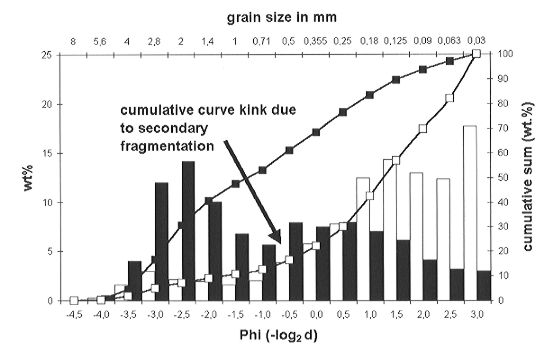

A critical aspect of the experimental investigation of magma fragmentation using the fragmentation bomb involves the possibility of secondary fragmentation. The fragmentation experiments are designed to investigate the case of a single decompression event leading to magma fragmentation. However, because our experiments are contained in a closed tank, and the exit velocities are sufficiently high; particles may impact the end of the fragmentation tank. This raises the possibility that a "secondary" fragmentation occurring there may skew the grain size distributions. To evaluate this possibility a set of experiments has been performed.
All six experiments were performed at 40 bar initial pressure difference and room temperature. In three of these experiments a steel plate was positioned in the low pressure tank, 60 cm above the diaphagm and directly in the trajectory of the fragments. This results in a reduction of the maximum umimpeded trajectory distance to a third of its original length. The steel plate was designed to enhance secondary fragmentation of the particles, which hit the plate with a speed of ca. 70 ms-1.
The experimental products with and without the plate were sieved identically.
The particle distribution curves are presented in Fig 3.7-6. This
figure illustrates two data sets, both as particle size distributions (bars)
and as cumulative curves of the particle size distributions (squares).
Comparison of data from the "no-plate" experiment (filled symbols) with
the "plate" experiment (hollow symbols) reveals a single major difference.
The results of the "plate" experiment indicate a significant shift of particle
size fractions to the smaller size classes and are clear evidence of secondary
fragmentation. Comparison of the cumulative curves show that the kink in
the cumulative distribution evident in the "plate" experimental data is
absent in the "no plate" data. This is a strong argument that the cumulative
curve of the "no plate" experiment is not measurably affected by secondary
fragmentation.
 |
Fig. 3.7-6: Particle size (Phi = -log2 d; where
d is grain size in mm) distribution and cumulative distribution curves
of "no plate" versus "plate" experiments on a synthetic glass foam at room
temperature and aan initial pressure of 40 bar. A shift of the grain size
distribution from coarse to fine with the addition of the plate is apparent.
Secondary fragmentation due to this plate results in a distinct kink in
the cumulative curve which is not present in "no plate" experiments. It
is important to note in this context that the double peak of the grain
size distribution has its origin in the material texture and is unrelated
to the secondary fragmentation processes. |

Tel: +49-(0) 921 55 3700 / 3766, Fax: +49-(0) 921 55 3769, E-mail: bayerisches.geoinstitut(at)uni-bayreuth.de
 Previous page
Previous page